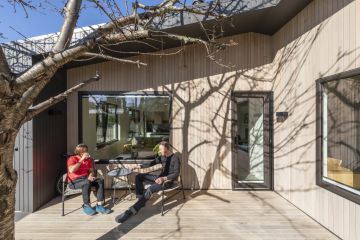Red Symons reflects on the creativity of architects

Imagine you have a dozen architecture students, each with the task of redesigning your place. It’s an academic exercise on the way to a master’s of architecture, a test set by professors.
I did imagine this years ago and, just as a comedian’s brilliant ad lib is really just an idea filed away waiting for the right moment, this moment finally arrived. “You should talk to …”
I have had a big square box of brick in the inner city for decades. It has been a warehouse to keep my things in. A passer-by told me it was once an abattoir. My neighbour, the real estate agent, said I had done the best thing in regard to it’s value, nothing at all – buy, wait, then a coat of white paint.
The students came over, as a group, to inspect and measure and I was struck by the thought that I have sons both older and younger than them. When do you stop telling them they’re marvellous?

Professor Andrew Hutson, their instructor, had briefed me that their ideas could be wildly creative without concern for budget, regulations or the more complicated laws of physics.
Professor Des Smith played slightly less good cop. I wasn’t the client with clear demands. I was “the client”.
In this scenario the architect has free rein. In your early 20s you can be filled with bravado and hidden doubt and I was the perfect “client” because I didn’t really know what I want. Just a diner looking at the menu.
I have been amused by my friends’ responses. Lawyers are outraged at what they imagine is a scam. A TV drama director suggested that since the ideas are, quite rightly, owned by the students, I should get them to sign release forms. All architects want to bowl it over and start again.

I remember once showing my friend, the carpenter Shirley Strachan, some architectural drawings on which a high-ceiling space was marked “void”.
“You’re paying for nothing there,” he advised. He wasn’t joking.
The process occupied a semester, about four months, and was conducted through teleconferencing. It’s the lockdown, remember.
This is what I have learnt. The male students have made display spaces. The female students have made somewhere to live.

Daniel has fashioned a bedroom for the late emperor to lie in state above the servants’ quarters; I love the stairs inside the brick pillar.
I like the idea of a building with a open space inside the walls, like a Roman villa. Until she presented it, I had never imagined, as Lindsay did, that I could grow a tree inside my house. Similarly, Jeremy has also put open space inside the containing walls. Now it’s a grand entrance to the Harry Potter mausoleum.
Neuman’s earlier design provided a transparent staircase to ascend between two pendulous cheeks above a forest of trunks. If it seems like you’re looking at the sky, that’s because there’s a mirror at a 45-degree angle behind the window at the back. I have become an exhibit at the Venice Biennale.
Some of the female students made traffic patterns, footsteps on the floor. This was once called a time and motion study and it’s an approach that emphasises what I will do rather than how I will appear.

The biggest and simplest thing that I have learnt is that while we have all imagined going up, who ever thought of going down? I have a concrete floor and I know a bloke with a jack-hammer.
Interestingly, in my psychological study of these students, most men don’t put in a bath and most women do. Like a jackdaw collecting shiny objects, I am charmed by a single detail from one of the students, Eden. If you have a sunken bath beneath a removable lattice and a shower above it, the bath is not in his way until she needs it.
I once had a house with a slate roof, or so it seemed. Most of the house had a tin roof but, from the street, you only saw slate.
Architects can make models and 3D drawings of a house in which the complex and varied tilts of the roof look terrific. If it’s constructed to scale who would the roof impress? Passers-by in balloons? Drones?

It’s an unusual luxury to have a dozen students make highly detailed suggestions as to how to tart up your shed, free from the burden of money, regulations and making cups of tea for the tradies.
I have observed clients complain that the architect has done nothing more than drawn what the client described – fulfilled the brief, in other words. While you may be inclined to determine the design to suit your tastes, remember this:
In this scenario the architect has free rein. In your early 20s you can be filled with bravado and hidden doubt and I was the perfect “client” because I didn’t really know what I want. Just a diner looking at the menu.The architect has thought a lot more about this than you ever will.
We recommend
Haliday Bay’s rare RV park site for sale
Historic pub changes hands for $40m
States
Capital Cities
Capital Cities - Rentals
Popular Areas
Allhomes
More










